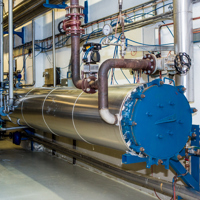Production sequence
Raw materials are unloaded to storage deposits, where they undergo a cooking, pressing and drying stage within the fishmeal plant.
Using top of the line equipment, selected from the best manufacturers in the world, the product undergoes cooking in indirect steam cookers with automatic temperature control.
Pressing is done in dual-screw presses, and drying is done in two stages: the first stage is drying under indirect steam, and the final stage uses low-temperature, indirect hot air.
The fishmeal is then cooled down and production is homogenized in silos. In the liquid phase, solids undergo separation in decanters. Oil separates in centrifuges, and tailing waters evaporate in a triple-effect evaporator.
Thanks to a modern laboratory where in-line control procedures are performed, and results are quickly reported, there is a strict quality control policy during the entire process.
Indirect hot air drying
LT (Low Temperature) fishmeal is made through indirect hot-air drying for 10 to 20 minutes at a temperature lower than 70ºC. Steam dried fishmeal is produced by direct contact with hot surfaces at 90 to 119ºC, for 1 to 2 hours.
High protein digestibility
Low-temperature manufactured fishmeal shows evidence for higher levels of protein digestibility. Several studies demonstrate a rise of 10-15%, measured by growth and feed utilization, comparing LT fishmeal with Standard fishmeal. This effect is valid for different fish species and also for other animals, as the table shows.
Lower conversion factor
This beneficial effect of high-quality fishmeal is also valid for salmon formulas that include sources of vegetable protein. The graph represents a relationship between higher protein digestibility in fishmeal (measured in Mink) and a higher relative growth rate, reaching a lower feed conversion factor.
Higher digestibility
Another advantage is a higher specific amino acid digestibility. Using low-temperature dried fishmeal with a high digestibility level allows more protein and amino acids to be available for the fish, therefore allowing better formula utilization. Furthermore, fresher raw materials keep more nutrients, avoids essential amino acid decay, and avoid the development of growth-retardant compounds by microbial development. In the graph, amino acid digestibility measured in trout and salmon for different fishmeal qualities significantly improves with LT fishmeal, especially for the most important amino acids like Lysine, Methionine and Histidine.
Lower effluent
Fishmeal quality also has a significant effect on the environment surrounding salmon fish farms. This impact is such that non-digestible organic matter effluent from Standard fishmeal can be as much as double the amount if compared to formulas that use low-temperature dried fishmeal, as the graph shows.


